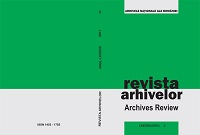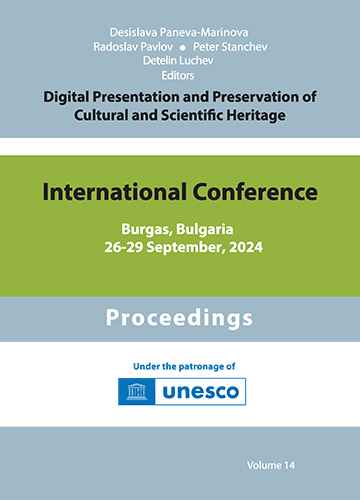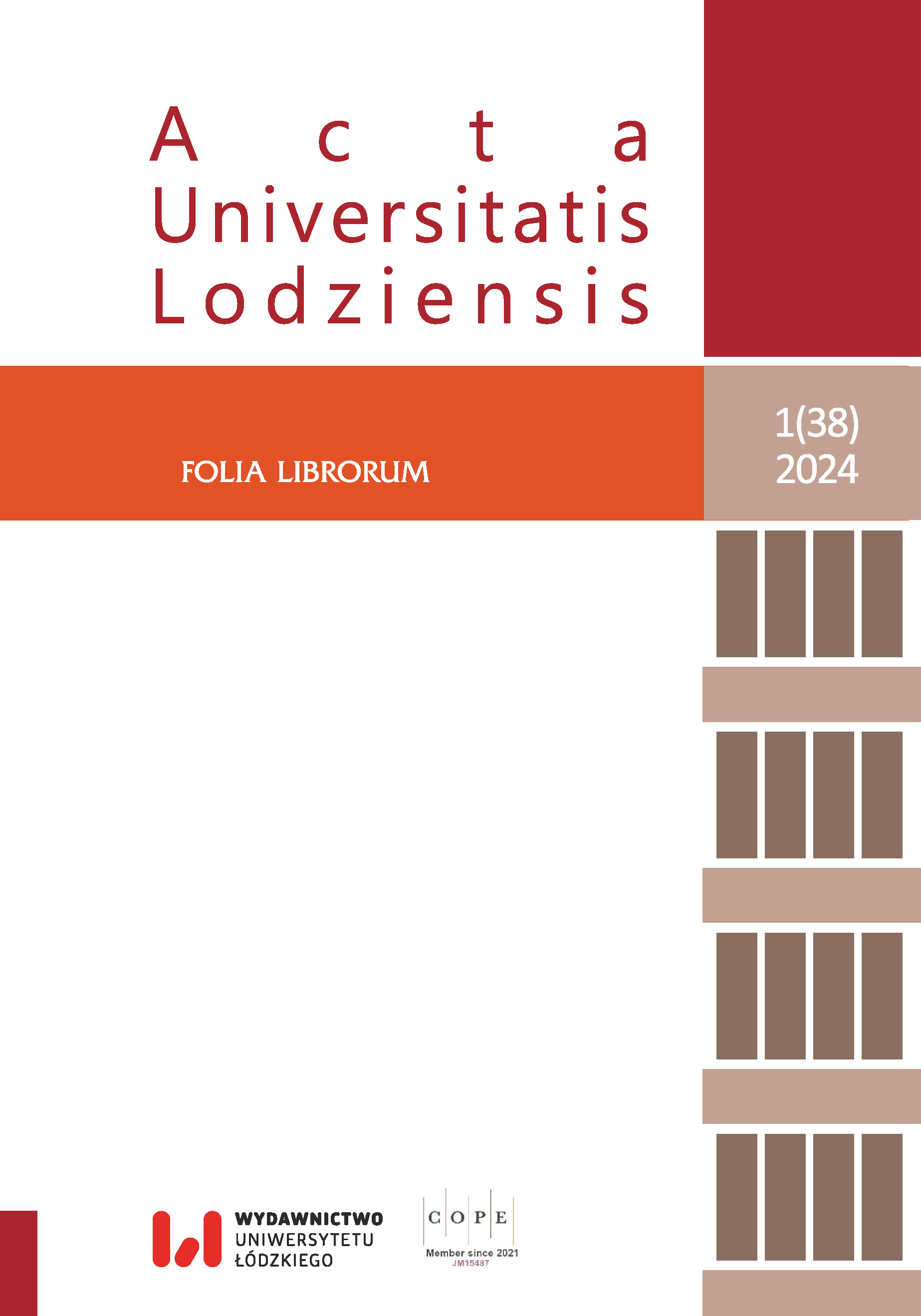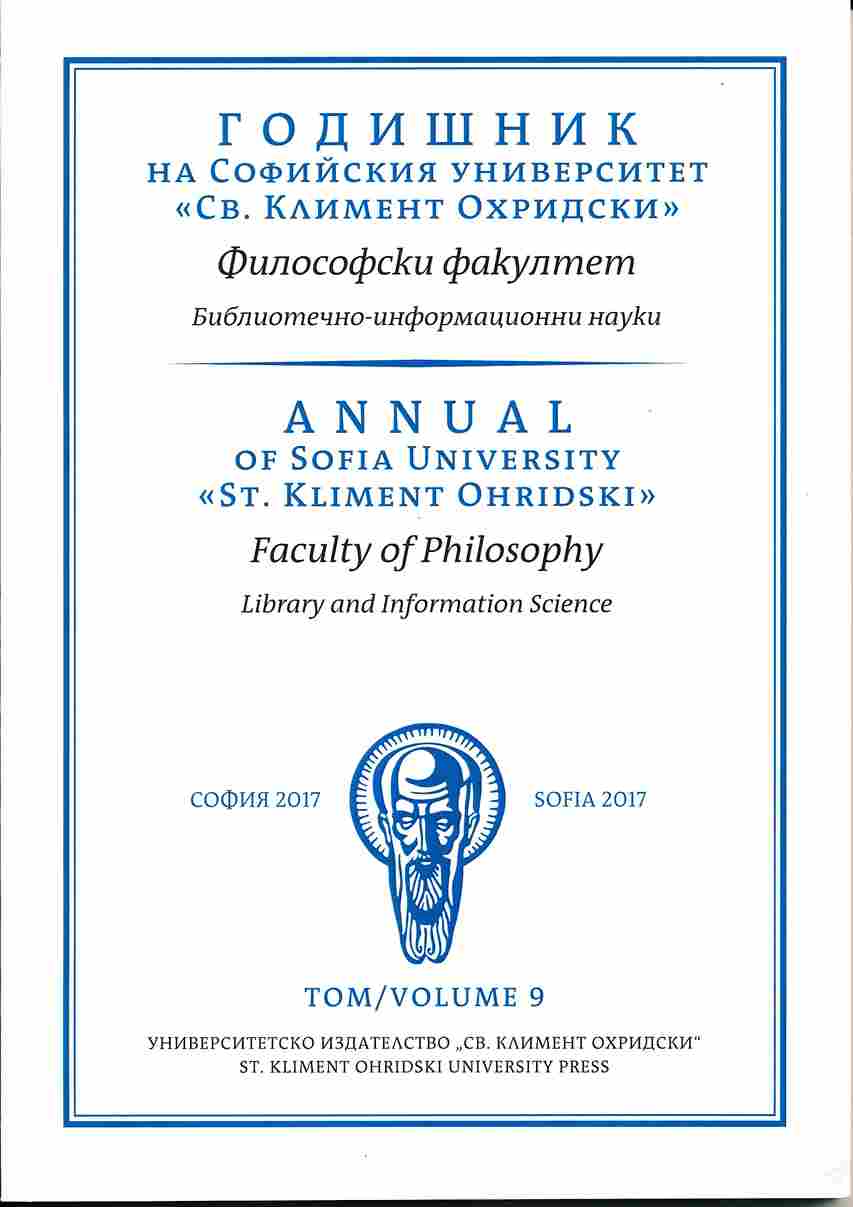
We kindly inform you that, as long as the subject affiliation of our 300.000+ articles is in progress, you might get unsufficient or no results on your third level or second level search. In this case, please broaden your search criteria.


In this paper the iSybislaw bibliographic database of World Slavic Linguistics publications is presented. The author demonstrates its vast potential as a research tool and citation source, concentrating on the possibilities of using all iSybislaw functions and options in university teaching and scientific research. The author points out that the database can be used not only by students and scientists of Slavic, Polish and Russian philology, but also, even if to a lesser extent, for philologies and linguistics of all languages.
More...
World of great working possibilities with all the types of digital information in all sciences and arts is being opened by computerization in the sphere of knowledge. Current information and communication systems receive, information processing and transmit information in the form of digital signals. Communication process of information into digital information system is named digitization. Information and communication systems dispose of digital information saved in electronic data bases. Systems of identifiers allow targeted information retrieval. DOI (Digital Object Identifier) is one of the most popular identifiers. It's used for identification of digital objects. DOI can be used for every type of intellectual property (physical, digital or abstract) which is named entity or object. DOI atributes document for some entity (name or series of characters) and it identifies that entity on digital network. Prerequisites for general progresss in the sphere of intellectual capital management are created by forming DOI system that means new possibilities for development of copyright law.
More...
In our country today we encounter various difficulties in collecting and managing archival records. These difficulties are determined by many factors, from the historical ones to the human factor. Although to certain extent this activity is regulated by the legislation approved by the competent bodies, we still face an incapable management of archival property. Under the dictates of limited possibilities, especially space, the State Agency of Kosovo Archives with all its composition, even two decades after the end of the war, failed to collect all the archival material as required by law. More than two thirds of the archival property that our Archive store today, is located outside our institution to various creators and fonds owners. This amount, grossly, is inherited from the time before the abolition of Kosovo's autonomy in 1989, which due to lack of space and other reasons we were able to collect and store in our repositories. Irresponsibility of the creators and the non-enforcement of legality is another element that has contributed to this situation, because they, even after the legal deadlines, continue to keep in their premises the archival material which they are obliged to submit to the Archives. They continue to manage it, although the right to manage this material by them, according to the law, expires 30 years after documents were created. From this time on, the preservation, protection, safety and provision of the use of archival documents is the sole responsibility and competence of the Archives, respectively of the State Agency of Kosovo Archives. Thus, today we have a mixed phenomenon of competencies for managing archival property, so within this topic, based on empirical data and legal analysis, the competencies and legal responsibilities for managing and usage of archival documents, which have exceeded 30 years after their creation, will be clarified.
More...
With the introduction of the IFLA Library Reference Model (IFLA LRM), authority control is becoming increasingly important, as authority data will play a key role in the network of linked data. Therefore, the preparation of authority data will help to facilitate the implementation of IFLA LRM and will be useful in the transition to RDA (Resource Description and Access).The paper presents an overview of authority data in the COBISS system, with a focus on the Slovenian COBISS.SI system, and suggests possibilities for the future development of authority records. It presents the status of the authority databases CONOR.SI and SGC, the submission of authority records to the VIAF service, and the acquisition and use of identifiers for personal and corporate body names. It also outlines IZUM’s plans for the transition to a new catalogue that will be in line with the IFLA LRM conceptual model. The basis for the development of the new COBISS catalogue is the selection of as large a set of entities as possible to be realised in authority records and the establishment of relationships between them.
More...
The purpose of the work is to represent the main areas of activity of Podillia public libraries under the conditions of martial law in Ukraine. The research methodology consists in the use of activity-based, humancentered and socio-communication approaches, which reflect changes in priorities in the functioning of the library and information sphere in the conditions of social threats. Also, general scientific (analysis, descriptive and generalization) and special (library) methods were used, which made it possible to realize the set goal. The scientific novelty of the presented work lies in the expansion of ideas about the role and significance of public libraries in Podillia in the life of communities during the difficult time of the Russian-Ukrainian war. The peculiarities of the main areas of activity of Podillia public libraries in the conditions of martial law in Ukraine are revealed. The relevance of the proposed topic is that work during the period of martial law in Ukraine shifted the emphasis on the priority of the basic functions of libraries, because they quite naturally, as socially oriented institutions, focused on the consolidation of the Ukrainian people on the way to Victory over the treacherous invader, which significantly increased their social role and positively affected their responsibility to society in general. Conclusions. It is proved that today the public libraries of Podillia are free public cultural and educational institutions that quickly provide open access to their own funds, information and knowledge for community residents (from preschoolers to the elderly, people with special needs) and all categories of remote users. successfully satisfy educational, leisure, spiritual, informational, educational, socialization and other needs of readers, try to "be everything to everyone". The priority of universal values in the activity of public libraries of Podillia, which in the conditions of martial law function in line with all-Ukrainian trends, put new tasks on the agenda, which are implemented through the active introduction of innovative forms, especially in the multimedia environment.
More...
The purpose of the article is research and analysis of the effectiveness of interaction with library and archival funds in the context of modern information and communication technologies. Not only the general aspects of using library resources, but also the methods of searching for scientific information are analysed. It is also expected to provide specific and detailed recommendations aimed at improving the quality and efficiency of interactions with scientific foundations. Current opportunities for using library resources are considered, considering modern requirements for information technologies and communication standards. The article sets itself the task of revealing not only general principles but also important details of working with these funds, in particular emphasising optimal strategies for searching for scientific information. The research methodology is based on the analysis of the spectrum of scientific literature, covering theoretical and practical foundations in the field of using library and archival resources. The methods used for finding scientific information are not limited to traditional sources, including various databases and catalogues, as well as innovative information and communication technologies. The scientific novelty of the article lies in the improvement of strategies and approaches to the use of library and archival funds, where the main emphasis is placed on the use of advanced information and communication technologies. The article reveals the potential of these technologies for effective search and use of scientific information, emphasising the importance of introducing innovations into the field of research. Conclusion. The results of the study indicate the need for constant adaptation of methods of working with library and archival funds to the requirements and capabilities of information technologies. The use of various databases and other information resources is key to improving the availability of scientific information and ensuring the efficient work of researchers and students. This approach contributes to the development of the scientific community, and its implementation helps to highlight the importance of innovation in ensuring successful work in the fields of scientific research and higher education.
More...
The article is a result of the work started in 2022 and aimed at creating “The List of Polish historical journals, rated by the Pracownia Naukoznawstwa IHN PAN (Science Studies and Science-of-Science Divion of the Institute for History of Science, Polish Academy of Sciences)”. The list contains an integrated and transparent technico-bibliometric evaluation of journals.The article presents the results of the review of 216 Polish journals in the field of history and archival science, in terms of their technical and bibliometric achievements, as evaluated by the Pracownia Naukoznawstwa IHN PAN (2021) on a scale of 0–200 points.The results were compared with the ministerial scores according to the Regulation of the Minister of Education and Science of December 21, 2021 and July 17, 2023.
More...
In this paper we will describe one of the most ambitious projects of the General Directorate of the Archives in the last years. After the successful accomplishment of the process of digitalization and on-line service, the coming project is the construction of the archival museum, a specific museum typology that aims to inform the vast public about the archival treasures.
More...
In the age of globalization and information technology, archives and archival cultural heritage are essential for understanding and studying the history and culture of a region. Regional cooperation can help in collecting important documentation, preserving and restoring archival materials, and promoting cultural heritage, thus contributing to the consolidation of the cultural identity of a region. Another advantage of regional cooperation is that it can help in exchanging information and expertise. This exchange can improve archival practices and enhance access to archival materials. Such cooperation can also help in improving the capacity of small archives and raising public awareness of the importance of archives and cultural heritage. To achieve these goals, it is important for regions to have a common strategy for archives and archival cultural heritage. This plan should include several key points, including improving archival infrastructure, improving access to archival materials, increasing cooperation between archival institutions in the region, and raising professional human capacity. In conclusion, this cooperation can help in collecting, preserving, and promoting archival materials and cultural heritage, to improve the internal systems of archives.
More...
At the beginning of the 20th century, the methods of collection protection used by Austrian librarians were related to the availability of materials used for this purpose, i.e., natural, chemical and biological agents. The primary preventive measure was maintaining library cleanliness (reading rooms and storerooms) and extensively vacuuming dust, mold, and dirt from objects. Among living organisms, mold, fungi, and insects were the greatest threat to library collections. Librarians used chemical fungicides (e.g., thymol and formalin) and proposed four methods for destroying insects: mechanical, chemical, physical, and biological. All activities undertaken by Austrian librarians indicate the awareness of the need to protect historical collections and the related use of old and new methods for securing collections.
More...
This article attempts to answer the question whether the websites of large Polish libraries apply principles of SEO (Search Engine Optimization). The study was conducted in four areas, including as follows: 1. study of key words (key word research, key word usage & key word density); 2. analysis of the on-page factors (content & technology); 3. analysis of off-page factors (backlinks & social media); 4. analysis of metrics reputation (brand & confidence metrics). The first area of research is based on the data generated from Google Adwords for the year 2014 (7.411.387 queries, 801 phrases); for subsequent areas material was provided by technical analysis of 13 most visited websites of libraries located in four major academic cities (Warsaw, Krakow, Poznan, Wroclaw). In the article the author examined in detail key words/ phrases, by which users search for local academic libraries, and also examined how the selected libraries’ websites implement SEO guidelines. The point of reference in the diagnosis of current factors were correlation reports of companies: Searchmetrics (SEO Ranking Factors and Rank Correlations 2014, 2015) and MOZ (Search Engine Ranking Factor 2015). Empirical research was based on data as of February 2015.
More...
Evaluation, which is an important part of the design process of a digital library, is essential in the process of improving the functionality of the library and recognition of users needs. The article presents an analysis of Polish and foreign literature, published mainly between 2000 and 2012, on evaluation of digital libraries, including the concepts of selections of digital library’s elements for evaluation, and also on criteria and methods of evaluation. The user- and system-centered approach to digital library evaluation were described. Among the presented evaluation methods, the user interface usability evaluation was highlighted as a popular and frequently used method, especially in researches conducted abroad. Additionally, user interface usability evaluation methods and holistic model of digital library evaluation were presented. The literature analysis includes researches conducted by Saracevic, Blandford, Borgman, Buchanan and Salako, Chowdhury and Chowdhury, Fuhr, Hang, Jeng, Kelly, Kochang, Janiak and Krakowska, Xie, Tsakonas, Kapidakis and Papatheodorou.
More...
In Serbia, there are many fortresses from the period 12th to 18th century, most of them in ruins, but a few being reconstructed and open to the public. This paper proposes an integral solution for application of information technologies in providing relatively detailed, visually attractive, and immersive presentation of the historic heritage related to these fortresses.
More...
This paper presents the advent in the presentation of cultural and historical heritage by using augmented reality (AR) technology. The use cases are given on the examples of mobile applications realized as electronic multimedia guides for various cultural institutions in Serbia. Then, a classification of the AR software is proposed based on their usage in the given examples.
More...
The article describes the possibilities of 3D documentation of historical monuments by photogrammetry on a selected sample of coins. It applies this selected method, verifies its suitability and describes some other digitization methods. It also contains a basic description of the methodology of creating 3D models of ancient coins.
More...
This paper studies problems related to the development of cross-stitch software as part of craft software. It treats an approach to the digital presentation of embroidery patterns. The software is designed for people engaged in traditional Bulgarian embroidery. In a digital way, the paper presents a variety of stitch types used in Bulgarian embroidery and a digital description of whole cross-stitch patterns. This study describes the entire pattern as a set of smaller groups of items. Often, some of these items are identical, which can facilitate pattern description. In general, the developed application is oriented toward Computer-aided Design stitch features of old cross-stitch patterns, which are found in ethnographic exhibits.
More...
The aim of this article is to present different ways of managing information in selected Cracow academic libraries. Four of Cracow's academic libraries were selected for the study, i.e. the Jagiellonian Library, the AGH University Main Library, the Main Library of the Pedagogical University of Cracow and The Cracow University of Technology Library. The article compares and analyses the services offered by the libraries to different user groups. The services provided by the agenda responsible for providing science information were discussed. These include queries, bibliometric analysis, group trainings and personalised courses. The article also presents the solutions which aim to improve the information literacy of today's library users, available into the institutions selected for the study.
More...
The paper discusses the main problems of understanding the mission of library professionals related to the build of the information culture of patrons and users of library resources and services. There are many statements, rules, guides, standards that are important in the creation of vital and flexible library information resources. Are they known of the librarians? Do professionals pay attention of influence of those papers on the (ìm)possibility of finding the necessary information? How we understand the future of information management?
More...
Archival institutions are legally authorized to preserve educational, historical, or archival documents. Under this context, this research explores the role and interest of Arab archival institutions in displaying official documents on their websites. This study delves into focusing on the service provision of archival institutions by providing a virtual exhibition of their documents. Method of content analysis helps this research analyze the exhibition’s characteristics, for instance, display of document type, size, metadata availability, research tools and instruments, and engraving the possibility to copy, download, or print documents. The sample size of the research included ten archival institutions in Arab, including Oman, Jordan, UAE, Tunisia, KSA, Iraq, Qatar, Libya, and Morocco. These institutes were selected based on the presence of archival document websites that provide text documents, photographs, and visual recordings. The analysis of the research uncovered the aspect that Arab archival institutes differ in their interest in exhibiting virtual documents and the type/number of documents available to the public. However, almost 50% of archival institutes provide metadata for displayed documents. They provide advanced characteristics, such as enlargement of images, search, download, and sharing, available in 33.3% of virtual exhibitions. This study recommends the establishment of control to select displayed documents compatible with different users. Moreover, the display of images and documents should include descriptive data that explains the nature and context of document creation and preservation. Virtual exhibition visitors must be surveyed with. their aspirations under consideration of the archival institute's policies and country-specific document management laws.
More...